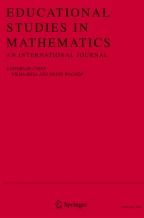Abstract
A task involving simple mathematics, yet complex in its call for the generation of multiple solution methods, was administered to about 150 U.S. students, most of whom were in fourth grade. Written responses were examined for correctness, evidence of strategy use and mode of explanation. Results for the U.S. sample were also compared to those obtained from about 200 Japanese fourth-grade students. Students in both countries (a) produced multiple solutions and explanations of their solutions, (b) exhibited almost identical patterns and frequency of strategy use across response occasions, and (c) used the same kinds of explanations, with a majority of the responses involving solution explanations that combined both visual and verbal/symbolic features. Nevertheless, Japanese students tended to produce explanations involving more sophisticated mathematical ideas (multiplication rather than addition) and formalisms (mathematical expressions rather than verbal explanations) than did U.S. students.
Similar content being viewed by others
References
Becker, J. P. (ed.): 1992,Report of U.S.-Japan Cross-National Research on Students' Problem Solving Behaviors, Columbus, OH: Eric Smoek Clearinghouse (ED 351-204).
Becker, J. P., and T. Miwa (eds.): 1987,Proceedings of the U.S.-Japan Seminar on Mathematical Problem Solving, Columbus, OH: Eric Smoek Clearinghouse (ED 304-315)
Ben-Chaim, D., G. Lappan and R. Houang: 1989, ‘Adolescents' ability to communicate spatial information: Analyzing and effecting students' performance’,Educational Studies in Mathematics 20, 121–146.
Duke, B.: 1986,The Japanese School: Lessons for Industrial America, Praeger Publishers, New York.
Hart, M. E., and K. Travers: 1992, ‘The matchsticks problem: Results of an analysis of U.S. students' solutions’, in J. P. Becker (ed.),Report of U.S.-Japan cross-national research on students' problem solving behaviors, Southern Illinois University, Carbondale, IL., p. 25–33.
Mayer, R. E., H. Tajika and C. Stanley: 1991, ‘Mathematical problem solving in Japan and the United States: A controlled comparison’,Journal of Educational Psychology 83, 69–72.
McKnight, C. C., F. J. Crosswhite, J. A. Dossey, E. Kifer, J. O. Swafford, K. J. Travers and T. J. Cooney: 1987,The Underachieving Curriculum: Assessing U.S. Mathematics from an International Perspective, Stipes Publishing Company, Champaign, IL.
Nagasaki, E.: 1990,An Analysis on the Results of Common Survey on ‘Marble Arrangement’ in Japan-U.S. Collaborative Research on Mathematical Problem Solving, National Institute for Educational Research, Tokyo.
Nagasaki, E., and S. Yoshikawa: 1989,Analysis of Japanese Results on ‘Marble Arrangement’ in Common Survey, National Institute for Educational Research, Tokyo.
Silver, E. A.: 1987, ‘Foundations of cognitive theory and research for mathematics problem solving and instruction’, in A. H. Schoenfeld (ed.),Cognitive Science and Mathematics Education, Lawrence Erlbaum Associates, Hillsdale, NJ., p. 33–60.
Stevenson, H. W., and S. Y. Lee: 1990,Contexts of Achievement: A Study of American, Chinese, and Japanese Children, University of Chicago Press, Chicago.
Stevenson, H. W., S. Y. Lee and J. W. Stigler: 1986, ‘Mathematics achievement of Chinese, Japanese, and American children’,Science 231, p. 693–699.
Stigler, J. W., S. Y. Lee, and H. W. Stevenson: 1987, ‘Mathematics classrooms in Japan, Taiwan, and the United States’,Child Development 58, p. 1272–1285.
Author information
Authors and Affiliations
Rights and permissions
About this article
Cite this article
Silver, E.A., Leung, S.S. & Cai, J. Generating multiple solutions for a problem: A comparison of the responses of U.S. and Japanese students. Educ Stud Math 28, 35–54 (1995). https://doi.org/10.1007/BF01273855
Issue Date:
DOI: https://doi.org/10.1007/BF01273855
